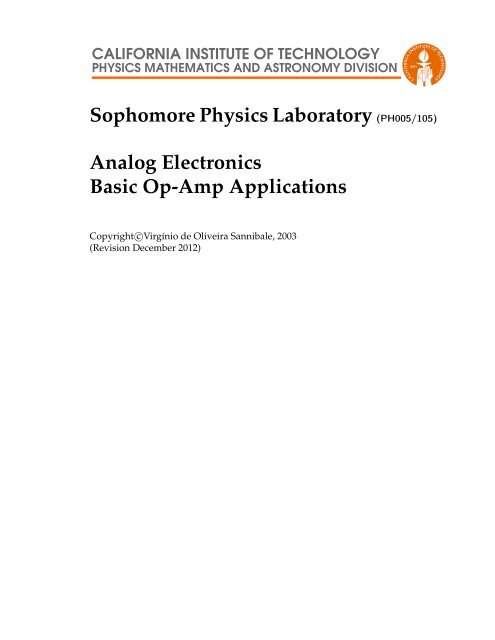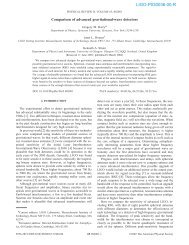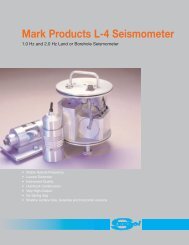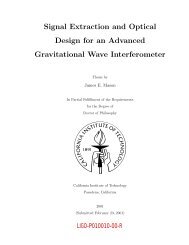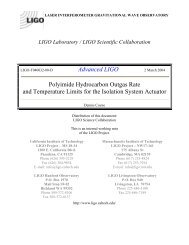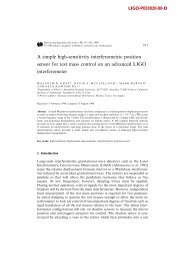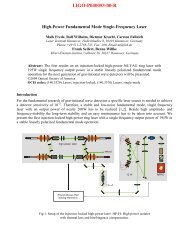Analog Electronics Basic Op-Amp Applications - LIGO
Analog Electronics Basic Op-Amp Applications - LIGO
Analog Electronics Basic Op-Amp Applications - LIGO
You also want an ePaper? Increase the reach of your titles
YUMPU automatically turns print PDFs into web optimized ePapers that Google loves.
CALIFORNIA INSTITUTE OF TECHNOLOGY<br />
PHYSICS MATHEMATICS AND ASTRONOMY DIVISION<br />
Sophomore Physics Laboratory (PH005/105)<br />
<strong>Analog</strong> <strong>Electronics</strong><br />
<strong>Basic</strong> <strong>Op</strong>-<strong>Amp</strong> <strong>Applications</strong><br />
Copyright c○Virgínio de Oliveira Sannibale, 2003<br />
(Revision December 2012)
Chapter 5<br />
<strong>Basic</strong> <strong>Op</strong>-<strong>Amp</strong> <strong>Applications</strong><br />
5.1 Introduction<br />
In this chapter we will briefly describe some quite useful circuit based on<br />
<strong>Op</strong>-<strong>Amp</strong>, bipolar junction transistors, and diodes.<br />
5.1.1 Inverting Summing Stage<br />
V 1<br />
R<br />
R f<br />
V 2<br />
V n<br />
I2<br />
In<br />
I1<br />
R<br />
R<br />
I<br />
A<br />
Figure 5.1: Inverting summing stage using an <strong>Op</strong>-<strong>Amp</strong>. The analysis of the<br />
circuit is quite easy considering that the node A is a virtual ground.<br />
Figure 5.1 shows the typical configuration of an inverting summing<br />
stage using an <strong>Op</strong>-<strong>Amp</strong>. Using the virtual ground rule for node A and<br />
107<br />
−<br />
+<br />
I<br />
V o<br />
DRAFT
108 CHAPTER 5. BASIC OP-AMP APPLICATIONS<br />
Ohm’s law we have<br />
I n = V N<br />
n<br />
R , I = ∑ I n .<br />
n=1<br />
Considering that the output voltage V 0 is<br />
V o = −R f I,<br />
we will have<br />
V o = A<br />
N<br />
∑<br />
n=1<br />
V n ,<br />
A = − R f<br />
R .<br />
5.1.2 <strong>Basic</strong> Instrumentation <strong>Amp</strong>lifier<br />
Instrumentation amplifiers (In-<strong>Amp</strong>) are designed to have the following<br />
characteristics: differential input, very high input impedance, very low<br />
output impedance, variable gain, high CMRR, and good thermal stability.<br />
Because of those characteristics they are suitable but not restricted to be<br />
used as input stages of electronics instruments.<br />
V i−<br />
V i+<br />
+<br />
G<br />
−<br />
−<br />
G<br />
+<br />
Input Stage<br />
R 2<br />
R 1<br />
−<br />
+<br />
R 1<br />
R 2<br />
Differential<br />
Stage<br />
Figure 5.2: <strong>Basic</strong> instrumentation amplifier circuit.<br />
Figure 5.2 shows a very basic In-<strong>Amp</strong> circuit made out of three <strong>Op</strong>-<br />
<strong>Amp</strong>s. In this configuration, the two buffers improve the input impedance<br />
of the In-<strong>Amp</strong>, but some of the problems of the differential amplifier are<br />
V o<br />
DRAFT
5.1. INTRODUCTION 109<br />
still present in this circuit, such as common variable gain, and gain thermal<br />
stability.<br />
A straightforward improvement is to introduce a variable gain on both<br />
amplifiers of the input stage as shown in Figure 5.3(a), but unfortunately,<br />
it is quite hard to keep the impedance of the two <strong>Op</strong>-<strong>Amp</strong>s well matched,<br />
and at the same time vary their gain and maintaining a very high CMRR.<br />
A clever solution to this problem is shown in Figure 5.3(b). Because of the<br />
virtual ground, this configuration is not very different from the previous<br />
one but it has the advantage of requiring one resistor to set the gain. In<br />
fact, if R 3 = R 4 then the gain of the <strong>Op</strong>-<strong>Amp</strong>s A 1 and A 2 can be set at the<br />
same time adjusting just R G .<br />
For an exhaustive documentation on instrumentation amplifiers consult<br />
[2].<br />
V i−<br />
+<br />
V i−<br />
+<br />
A 1 A 1<br />
−<br />
−<br />
R 3<br />
R G<br />
R 4<br />
R 2<br />
−<br />
−<br />
A<br />
V 2 A<br />
i+ V 2<br />
i+<br />
R 1<br />
+<br />
+<br />
R 3<br />
R 4<br />
(a)<br />
Figure 5.3: Improved input stages of the basic instrumentation amplifier.<br />
5.1.3 Voltage to Current Converter (Transconductance <strong>Amp</strong>lifier)<br />
A voltage to current converter is an amplifier that produces a current proportional<br />
to the input voltage. The constant of proportionality is usually<br />
called transconductance. Figure 5.4 shows a Transconductance <strong>Op</strong>-<strong>Amp</strong>,<br />
which is nothing but a non inverting <strong>Op</strong>-<strong>Amp</strong> scheme.<br />
(b)<br />
DRAFT
110 CHAPTER 5. BASIC OP-AMP APPLICATIONS<br />
i f<br />
R Z f<br />
R f<br />
Z f<br />
−<br />
+<br />
v (t)<br />
s<br />
<strong>Amp</strong>erometer<br />
Figure 5.4: <strong>Basic</strong> transconductance amplifier circuit.<br />
The current flowing through the impedance Z f is proportional to the<br />
voltage v s . In fact, assuming the <strong>Op</strong>-<strong>Amp</strong> has infinite input impedance,<br />
we will have<br />
i f (t) = v s(t)<br />
R .<br />
Placing an amperometer in series with a resistor with large resistance<br />
as a feedback impedance, we will have a high resistance voltmeter. In<br />
other words, the induced perturbation of such circuit will be very small<br />
because of the very high impedance of the operational amplifier.<br />
5.1.4 Current to Voltage Converter (Transresistance <strong>Amp</strong>lifier)<br />
A current to voltage converter is an amplifier that produces a voltage proportional<br />
to the input current. The constant of proportionality is called<br />
transimpedance or transresistance, and its units are Ω. Figure 5.5 show a<br />
basic configuration for a transimpedance <strong>Op</strong>-<strong>Amp</strong>. Due to the virtual<br />
ground the current through the shunt resistance is zero, thus the output<br />
voltage is the voltage difference across the feedback resistor R f , i.e.<br />
v o (t) = −R f i s (t).<br />
Photo-multipliers photo-tubes and photodiodes drivers are a typical<br />
application for transresistance <strong>Op</strong>-amps. In fact, quite often the photocurrent<br />
produced by those devices need to be amplified and converted<br />
into a voltage before being further manipulated.<br />
DRAFT
5.2. LOGARITHMIC CIRCUITS 111<br />
i s<br />
R f<br />
−<br />
i s<br />
R s<br />
+<br />
v o =−i s R f<br />
Figure 5.5: <strong>Basic</strong> transimpedance <strong>Op</strong>-<strong>Amp</strong>.<br />
5.2 Logarithmic Circuits<br />
By combining summing circuits with logarithmic and anti-logarithmic amplifiers<br />
we can build analog multipliers and dividers. The circuits presented<br />
here implements those non-linear operations just using the exponential<br />
current response of the semiconductor junctions. Because of that,<br />
they lack on temperature stability and accuracy. In fact, the diode reverse<br />
saturation current introduces an offset at the circuits output producing a<br />
systematic error. The temperature dependence of the diode exponential response<br />
makes the circuit gain to drift with the temperature. Nevertheless<br />
these circuits have a pedagogical interest and are the basis for more sophisticated<br />
solutions. For improved logarithmic circuits consult [1] chapter 7,<br />
and [1] section 16-13 and[3].<br />
v<br />
i<br />
R<br />
(a)<br />
−<br />
+<br />
D<br />
v<br />
v i<br />
o −<br />
v o<br />
Figure 5.6: Elementary logarithmic amplifiers using a diode or an npn BJT.<br />
R<br />
(b)<br />
+<br />
Q<br />
DRAFT
112 CHAPTER 5. BASIC OP-AMP APPLICATIONS<br />
5.2.1 Logarithmic <strong>Amp</strong>lifier<br />
Figure 5.6 (a) shows an elementary logarithmic amplifier implementation<br />
whose output is proportional to the logarithm of the input. Let’s analyze<br />
this non-linear amplifier in more detail.<br />
The <strong>Op</strong>-<strong>Amp</strong> is mounted as an inverting amplifier, and therefore if v i<br />
is positive, then v o must be negative and the diode is in conduction. The<br />
diode characteristics is<br />
)<br />
i = I s<br />
(e −qv o/k B T − 1 ≃ I s e −qv o/k B T<br />
I s ≪ 1,<br />
where q < 0 is the electron charge. Considering that<br />
after some algebra we finally get<br />
i = v i<br />
R ,<br />
v o = k BT<br />
−q [ln(v i)−ln(RI s )] .<br />
The constant term ln(RI s ) is a systematic error that can be measured<br />
and subtracted at the output. It is worth to notice that v i must be positive<br />
to have the circuit working properly. An easy way to check the circuit is to<br />
send a triangular wave to the input and plot v o versus v i .<br />
Because the BJT collector current I c versus V BE is also an exponential<br />
curve, we can replace the diode with an npn BJT as shown in Figure 5.6.<br />
The advantage of using a transistor as feedback path is that it should provide<br />
a larger input dynamic range.<br />
If the circuit with the BJT oscillates at high frequency, a small capacitor<br />
in parallel to the transistor should stop the oscillation.<br />
5.2.2 Anti-Logarithmic <strong>Amp</strong>lifier<br />
Figure 5.7 (a) shows an elementary anti-logarithmic amplifier, i.e. the output<br />
is proportional to the inverse of logarithm of the input. The current<br />
flowing through the diode is<br />
i ≃ I s e −qv i/k B T<br />
I s ≪ 1.<br />
DRAFT
5.2. LOGARITHMIC CIRCUITS 113<br />
R<br />
R<br />
v<br />
i<br />
D<br />
−<br />
Q<br />
v<br />
v i<br />
o −<br />
v o<br />
+<br />
+<br />
(a)<br />
(b)<br />
Figure 5.7: Elementary anti-logarithmic amplifiers using a diode or an pnp BJT.<br />
Considering that<br />
thus<br />
v o = −Ri ,<br />
v o ≃ −RI s e −qv i/k B T .<br />
If the input v i is negative, we have to reverse the diode’s connection. In<br />
case of the circuit of Figure 5.7 (b) we need to replace the pnp BJT with an<br />
npn BJT. Same remarks of the logarithmic amplifier about the BJT, applies<br />
to this circuit.<br />
v 1<br />
v 2<br />
Logarithmic<br />
<strong>Amp</strong>lifier<br />
Logarithmic<br />
<strong>Amp</strong>lifier<br />
R<br />
R<br />
−<br />
+<br />
Anti−Log<br />
<strong>Amp</strong>lifier<br />
Figure 5.8: Elementary analog multiplier implementation using logarithmic and<br />
anti-logarithmic amplifiers<br />
R<br />
v o<br />
DRAFT
114 CHAPTER 5. BASIC OP-AMP APPLICATIONS<br />
5.2.3 <strong>Analog</strong> Multiplier<br />
Figure 5.8 shows an elementary analog multiplier based on a two log one<br />
anti-log and one adder circuits. Fore more details about the circuit see [1]<br />
section 7-4 and [1] section 16-13.<br />
R<br />
v 1<br />
v 2<br />
Logarithmic<br />
<strong>Amp</strong>lifier<br />
Logarithmic<br />
<strong>Amp</strong>lifier<br />
R<br />
R<br />
−<br />
+<br />
Anti−Log<br />
<strong>Amp</strong>lifier<br />
v o<br />
R 0<br />
Figure 5.9: Elementary analog divider implementation using logarithmic and<br />
anti-logarithmic amplifiers.<br />
5.2.4 <strong>Analog</strong> Divider<br />
Figure 5.8 shows an elementary logarithmic amplifier based on a two log<br />
one anti-log and one adder circuits. Fore more details about the circuit see<br />
[1] section 7-5 and [1] section 16-13.<br />
5.3 Multiple-Feedback Band-Pass Filter<br />
Figure 5.10 shows the so called multiple-feedback bandpass, a quite good<br />
scheme for large pass-band filters, i.e. moderate quality factors around 10.<br />
Here is the recipe to get it working. Select the following parameter<br />
which define the filter characteristics, i.e the center angular frequency ω 0<br />
the quality factor Q or the the pass-band interval (ω 1 , ω 2 ) , and the passband<br />
gain A pb<br />
DRAFT
R 2<br />
R 0<br />
5.3. MULTIPLE-FEEDBACK BAND-PASS FILTER 115<br />
R 3<br />
V i<br />
C 1<br />
R 1<br />
C 2<br />
−<br />
V o<br />
+<br />
G<br />
Figure 5.10: Multiple-feedback band-pass filter.<br />
ω 0 = √ ω 2 ω 1<br />
ω 0<br />
Q =<br />
ω 2 − ω 1<br />
A pb < 2Q 2<br />
Set the same value C for the two capacitors and compute the resistance<br />
values<br />
Verify that<br />
R 1 =<br />
R 2 =<br />
R 3<br />
Q<br />
ω 0 CA pb<br />
Q<br />
ω 0 C(2Q 2 − A pb )<br />
= 2Q<br />
ω 0 C<br />
A pb = R 3<br />
2R 1<br />
< 2Q 2<br />
See [1] sections 8-4.2, and 8-5.3 for more details.<br />
DRAFT
116 CHAPTER 5. BASIC OP-AMP APPLICATIONS<br />
5.4 Peak and Peak-to-Peak Detectors<br />
The peak detector circuit is shown in Figure 5.11. The basic ideal is to<br />
implement an integrator circuit with a memory.<br />
To understand the circuit letŽs first short circuit D o and remove R.<br />
Then the <strong>Op</strong>-amp A 0 is just a unitary gain voltage follower that charges<br />
the capacitor C up to the peak voltage. The function of D 0 and of A 1 (high<br />
input impedance) is to prevent the fast discharge of the capacitor.<br />
Because of D 0 the voltage across the capacitor is not the max voltage at<br />
the input, and this will create a systematic error at the output v o . Placing<br />
a feedback from v o to v i will fix the problem. In fact, because v + must be<br />
equal to v − , A 0 will compensate for the difference.<br />
Introducing the resistance (R ≃ 100kΩ) in the feedback will provide<br />
some isolation for v o when v i is lower than v C .<br />
The <strong>Op</strong>-<strong>Amp</strong> A 0 should have a high slew rate (~20 V/µs) to avoid the<br />
maximum voltage being limited by the <strong>Op</strong>-<strong>Amp</strong> slew rate.<br />
The capacitor doesn’t have to limit the <strong>Op</strong>-<strong>Amp</strong> A 0 slew rate S, i. e.<br />
i C<br />
C ≪ dv<br />
dt = S<br />
It is worthwhile to notice that if D 0 and D 1 are reversed the circuit<br />
becomes a negative peak detector.<br />
The technology of the hold capacitor C is important in this application.<br />
The best choice to reduce leakage is probably polypropylene, and after<br />
that polystyrene or Mylar.<br />
Using a positive and a negative peak detector as the input of a differential<br />
amplifier stage we can build a peak-to-peak detector (for more<br />
details see [1] section 9-1). Some things to check: holding time (a given %<br />
drop from the maximum) versus capacitor technology, systematic errors ,<br />
settling time required for the output to stabilize.<br />
5.5 Zero Crossing Detector<br />
When v i is positive and because it is connected to the negative input then<br />
v o becomes negative and the diode D 1 is forward biased and conducting.<br />
DRAFT
5.6. ANALOG COMPARATOR 117<br />
D 0<br />
v C<br />
v i<br />
A<br />
D 1<br />
R<br />
−<br />
+<br />
−<br />
+<br />
A<br />
v o<br />
C 0<br />
RESET<br />
Figure 5.11: Peak detector circuit.<br />
5.6 <strong>Analog</strong> Comparator<br />
An analog comparator or simply comparator is a circuit with two inputs v i ,<br />
v re f and one output v o which fulfills the following characteristic:<br />
{<br />
V1 , v<br />
v o =<br />
i > v re f<br />
V 2 , v i ≤ v re f<br />
An <strong>Op</strong>-<strong>Amp</strong> with no feedback behaves like a comparator. In fact, if we<br />
apply a voltage v i > v re f , then V + − V − = v i − v re f > 0. Because of the<br />
high gain, the <strong>Op</strong>-<strong>Amp</strong> will set v o to its maximum value +V sat which is a<br />
value close to the positive voltage of the power supply. If v i < v re f , then<br />
v o = −V sat . The magnitude of the saturation voltage are typically about<br />
1V less than the supplies voltages.<br />
Depending on which input we use as voltage reference v re f , the <strong>Op</strong>amp<br />
can be an inverting or a non inverting analog comparator.<br />
It is worthwhile to notice that the analog comparator circuit is also a 1<br />
bit analog digital converter , which converts voltages to the two levels V 1<br />
and V 2 .<br />
DRAFT
118 CHAPTER 5. BASIC OP-AMP APPLICATIONS<br />
V i<br />
V 1<br />
−<br />
+<br />
V o<br />
R +<br />
R f<br />
(utp)<br />
V +<br />
t<br />
(ltp)<br />
V +<br />
+V sat<br />
t<br />
−V sat<br />
Figure 5.12: Schmitt Trigger and its qualitative response to a signal that swings<br />
up and down between and through the saturation voltages±V sat .<br />
5.7 Regenerative Comparator (The Schmitt Trigger)<br />
The Regenerative comparator or Schmitt Trigger 1 shown in Figure 5.12 is a<br />
comparator circuit with hysteresis.<br />
It is important to notice that the circuit has a positive feedback. With<br />
positive feedback, the gain becomes larger than the open loop gain making<br />
the comparator to swing faster to one of the saturation levels.<br />
1 Otto Herbert Schmitt (1913-1998) American scientist considered the inventor of this<br />
device, that appeared in an article in 1938 with the name of "thermionic trigger"[3].<br />
DRAFT
5.8. PHASE SHIFTER 119<br />
Considering the current flowing through R + and R f ,we have<br />
I = V 1− V +<br />
R +<br />
= V +− V o<br />
R f<br />
, ⇒ V + = V 1R f + V o R +<br />
R f + R +<br />
.<br />
The output V o can have two values, ±V sat . Consequently, V + will assume<br />
just two trip points values<br />
V (utp)<br />
+ = V 1R f + V sat R +<br />
R f + R +<br />
V (ltp)<br />
+ = V 1R f − V sat R +<br />
R f + R +<br />
When V i < V (utp)<br />
+ , V o is high, and when V i < V (ltp)<br />
+ , V o is low.<br />
To set V + = 0 it requires that<br />
V 1 = − R +<br />
R f<br />
V o<br />
This circuit is usually used to drive an analog to digital converter (ADC).<br />
In fact, jittering of the input signal due to noise which prevents from keeping<br />
the output constant, will be eliminated by the hysteresis of the Schmitt<br />
trigger (values between the trip points will not affect the output).<br />
See [1] section 11 for more detailed explanations.<br />
Example1: (V sat = 15V)<br />
Supposing we want to have the trip points to be V + = ±1.5V, if we set<br />
V 1 = 0 then R f = 9R + .<br />
5.8 Phase Shifter<br />
A phase shift circuit shown in Figure 5.13, produces a sinusoidal signal<br />
at the output V o which is equal to the sinusoidal input V i with a defined<br />
phase shift . The basic idea of this clever circuit is to subtract using an<br />
<strong>Op</strong>-<strong>Amp</strong> two equal sinusoids one of which is lagging behind because is<br />
low pass filtered (the difference of these two same frequency sinusoid is a<br />
phase shifted attenuated sinusoid). The <strong>Op</strong>-<strong>Amp</strong> provides also the unitary<br />
gain.<br />
DRAFT
120 CHAPTER 5. BASIC OP-AMP APPLICATIONS<br />
V i<br />
R 0<br />
R 0<br />
−<br />
+<br />
V o<br />
R<br />
C<br />
Figure 5.13: Phase shifter circuit.<br />
Using the same method applied to compute the differential <strong>Op</strong>-<strong>Amp</strong><br />
stage transfer function, we obtain<br />
H(ω) =<br />
1− jωRC<br />
1+ jωRC ,<br />
The amplitude and phase of the transfer function are therefore<br />
H(ω) = 1<br />
for any frequency,<br />
ϕ(ω) = arctan(−ωRC)− arctan(ωRC) = −2 arctan(ωRC) .<br />
The phase shift is double the one of a simple low pass filter and therefore<br />
can go from 0 ◦ down to −180 ◦ . Exchanging the potentiometer and<br />
the capacitor changes the phase lag to a phase lead.<br />
Example<br />
Supposing that we want a phase shift of −90 ◦ for a 1 kHz sinusoid with<br />
capacitor with a reasonable capacitance value C = 10 nF, then<br />
R =<br />
( ϕ<br />
− tan<br />
2)<br />
Cω<br />
=<br />
1<br />
10 −8· = 15.915 kΩ.<br />
2π·103 The value of R 0 can be in the range of few kilohoms to tens kilohoms.<br />
DRAFT
5.9. GENERALIZED IMPEDANCE CONVERTER (GIC) 121<br />
5.9 Generalized Impedance Converter (GIC)<br />
A<br />
+<br />
−<br />
Z 1<br />
Z 2<br />
Z 3<br />
+<br />
−<br />
Z 4<br />
Z 5<br />
A<br />
Z<br />
Figure 5.14: Generalized Impedance Converter (GIC).<br />
The fundamental equation of the GIC, which can be found after tedious<br />
calculation, is<br />
Z = Z 1Z 3 Z 5<br />
Z 2 Z 4<br />
By a careful choice of passive components, one can implement types<br />
of impedance with values impossible to attain with standard passive components.<br />
This holds true where the <strong>Op</strong>-<strong>Amp</strong>s behave very closely to ideal<br />
<strong>Op</strong>-<strong>Amp</strong>s and if one lead of Z is grounded. For example, we can make:<br />
• C to L converter and vice versa,<br />
• LC parallel to LC series and vice versa,<br />
• impedance scaler<br />
• negative resistance<br />
DRAFT
122 CHAPTER 5. BASIC OP-AMP APPLICATIONS<br />
This circuit is also a gyrator, i.e. a two voltage controlled current sources,<br />
where the currents have opposite direction. For more details consult [7].<br />
5.9.1 Capacitor to Inductor Converter<br />
If we choose, for example,<br />
then the GIC becomes<br />
Z 1 = Z 2 = R 1 , Z 3 = R 3 , Z 4 = 1<br />
jωC , Z 5 = R 5 ,<br />
Z = jωR 3 R 5 C .<br />
The circuit will behave as an inductor with inductance L = R 3 R 5 C. If<br />
we chose large resistance values R 3 , R 5 and reasonably large capacitance<br />
values C, we can implement very large inductance values practically impossible<br />
to attain using standard inductors.<br />
DRAFT
5.10. PROBLEMS PREPARATORY TO THE LABORATORY 123<br />
5.10 Problems Preparatory to the Laboratory<br />
1. Considering the following circuit, determine the voltage output V o<br />
for the following input voltages V i = −2V, 1V, 1.5V, 3V<br />
+10V<br />
V i<br />
+1.5V<br />
−<br />
+<br />
G<br />
V o<br />
−10V<br />
2. Consider the Schmitt trigger of Figure 5.12.<br />
(a) If V o = −15V and V + = 0V, compute V 1 .<br />
(b) If V o = +15V, and V 1 = 15V, compute V + .<br />
3. Design a Schmitt trigger with two diode clamps and one resistor connected<br />
to the output.<br />
(a) Limit the output V o from 0 to 5V.<br />
(b) Compute the resistance value R necessary to limit the diode current<br />
to 10mA.<br />
4. What is the practical maximum and minimum output voltage of the<br />
logarithmic amplifier in Figure 5.6?<br />
5. Chose and study at least two circuits to study and design, one from<br />
this chapter and one form the next one on active filters .<br />
New circuits different than those ones proposed in this chapter are<br />
also welcome. For a good source of new circuits based on <strong>Op</strong>-<strong>Amp</strong>s<br />
see [1] , [4], and [2].<br />
DRAFT
124 CHAPTER 5. BASIC OP-AMP APPLICATIONS<br />
DRAFT
Bibliography<br />
[1] Luces M. Faulkenberry, An introduction to <strong>Op</strong>erational <strong>Amp</strong>lifiers<br />
with Linear IC <strong>Applications</strong>, Second Edition.<br />
[2] Charles Kitchin and Lew Counts, A Designer’s Guide to<br />
Instrumentation <strong>Amp</strong>lifiers (2nd Edition), <strong>Analog</strong> Devices<br />
(http://www.analog.com/en/DCcList/0,3090,759%255F%255F42,00.html)<br />
[3] Theory and <strong>Applications</strong> of Logarithmic <strong>Amp</strong>lifiers, National<br />
Semiconductors, AN-311 ( http://www.national.com/an/AN/AN-<br />
311.pdf ).<br />
[4] Horowitz and Hill, The Art of <strong>Electronics</strong>, Second Edition<br />
[5] Microelectronics Jacob Millman & Arvin Grabel, McGraw-Hill Electrical<br />
Engineering Series<br />
[6] A thermionic trigger, Otto H Schmitt 1938 J. Sci. Instrum. 15 24-26.<br />
[7] Sedra Smith, Microelectronics Circuits, third edition, Oxford University<br />
Press.<br />
125<br />
DRAFT
126 BIBLIOGRAPHY<br />
DRAFT


